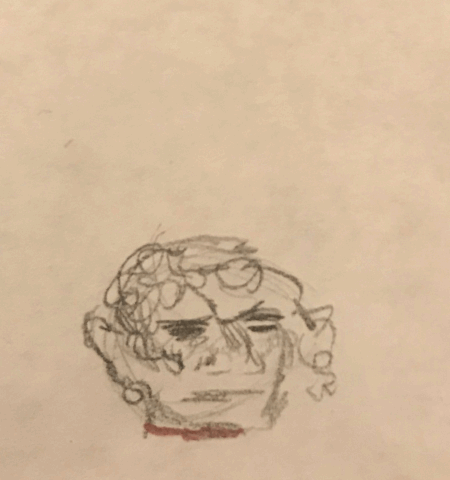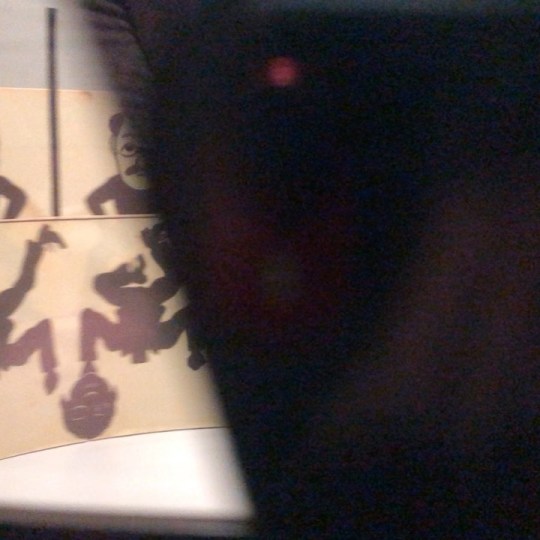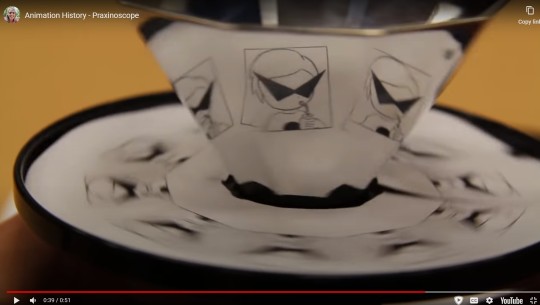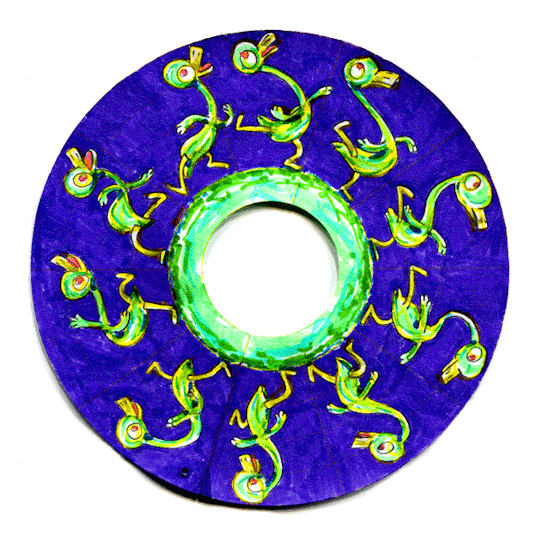#praxinoscop
Text
'SS Rajamouli' And The 'Praxinoscope' By Creative Multimedia | The Best Animation College In India
youtube
The word “PRAXINOSCOPE” has Greek roots and translates roughly into "action viewer". A precursor to the moving picture, the Praxinoscope is an animation device invented in the year 1877 by Charles Emile Reynaud in France. The device was used to view a moving picture in a mirror. ‘Persistence of Vision.'
0 notes
Video
youtube
Praxinscope Animations by Émile Reynaud
2 notes
·
View notes
Text



Took a class a couple years ago where we did some experimental animations...so here's a Carton head-bounce (because of course) on something called a praxinoscope!
[alt. text included!]
#Sydney Carton#A Tale of Two Cities#AToTC#Dickens#praxinoscope#Waffle Art#traditional#pencil#gif#animation#this was very fun to do#i'd actually done a sketchbook animation of his head bouncing like this wayyy back when#(it may or may not be on here I can't remember)#so it was fun to have an academic excuse to try that again in a kind-of new medium!#it's a very fun exercise#will be posting more from this class and from another !
8 notes
·
View notes
Text
instagram
#funny#motion#devices#image#toy#invention#optical#movement#thaumatrope#anorthoscope#zoetrope#praxinoscope#zoopraxiscope#theatreoptique#theatre#drawing#illustration#atlas#curiosity#Instagram
0 notes
Photo

Image animée @museocinema #museonazionaledelcinema #torino #praxinoscope #zoetrope #zootrope #cinema #kineticart (à Museo Nazionale del Cinema di Torino) https://www.instagram.com/p/CeodlvELPLV/?igshid=NGJjMDIxMWI=
0 notes
Photo

had to watch a video for my history of animation class and got fucking JUMPSCARED
which one of you fucks put dave strider in the praxinoscope
2K notes
·
View notes
Text

Oh yeah also here's a screenshot of my other in-the-works project that I haven't had a lot of time to work on in the middle of trying to crowdfund our fucking groceries and survive capitalism.
If you want to help support this project, pledge to my Patreon.
I haven't posted many updates so far in 2023, but that's directly because of the aforementioned "I'm really exhausted trying to survive capitalism." Did I mention how tired I am of begging for grocery money on tumblr? Because I'm pretty tired of having to beg for grocery money on tumblr.
Image transcript below:
A History of Queer American Animation
by Ren Basel
Thesis
The late 2010s saw a turning point in queer representation in animation, with the production of shows such as Steven Universe and She-Ra & the Princesses of Power—but they weren’t the first cartoons to show queer characters. Queerness has a long history in American animated media, stretching back to the very foundations of the medium.
Notes
Before Mickey: The Animated Film 1898-1928, by Donald Crafton
Cinema had already gained a reputation as “highbrow” and “intellectual” by the 1920s.
From its origins, animation was regarded as a “minor branch” of cinema. In the silent film period, animation was considered commercially insignificant by distributors and scholars.
Steamboat Willie premiered at the Colony Theater in New York on November 18, 1928, and was the animated equivalent to the live-action film “The Jazz Singer,” bringing together moving pictures and synchronized sound.
The cinema came into existence in 1895. The specific origins of animation, however, are hazy, with the first commercial animation appearing in 1898, but no clear record of when animation technology really “began.”
Precursors of modern animation include historical sequential art such as hieroglyphic friezes, Chinese scrolls, and the Bayeux Tapestry. Other examples of proto-animation include magic lanterns, the Fantascope, slide projections, shadow plays, and other optical tricks and curiosities.
Emile Reynaud (1844-1918), often called “the father of the animated cartoon,” was a teacher of math and science. He created the praxinoscope, a gadget that used revolving mirrors to reflect drawings, which the viewer could see without looking through slits as in prior moving-picture devices. In 1879, Reynaud refined the tabletop “praxinoscope theater,” and further developed the device into an audience theater in 1892, called the Theatre Optique in Paris.
Many animation pioneers were inspired by flipbooks.
221 notes
·
View notes
Note
List 5 things that make you happy, then put this in the askbox for the last 10 people who liked or reblogged something from you! Get to know your mutuals and followers
Love youuuu <333
Awwwwww <3
Anthropology - I love learning about how humans have always been humans. It helps us better understand how people solve problems.
Times that animals solve human-caused problems - ie. The maggots that eat styrofoam and the orcas that destroy the yacht rudders.
Old forms of entertainment that contain simple machines - ie. All puppets, automata, praxinoscopes, kites, etc. They showcase how creative and ingenuitive humanity has always been. And that they had free time to do things they loved and weren't always just trying to survive.
Genre Movies that go all out with their genera - A lot of the time movies are put into genres for advertising purposes or just cus that genera happens to fit the story and theme. I love it when movies are made in a certain genre for the love the creators have for it and its tropes. I love it when Genre moves are hammed up to almost the point of uncomfortability. It's the creator unapologetically depicting their love for the experience of viewing a movie in their favorite genre.
THEIRRY MUGLER - He is an entirely underrated fashion designer at least in the online sphere. He's who designed Zendeya's robot red carpet look for the Dune Part 2 premiere. His designs were extremely stylish and extremely campy which can be something very hard to pull off at the risk of tackiness. He pushed every idea to 1000%. His fashion shows were an experience and he let his models have personality because he wasn't afraid of being overshadowed. He let the two work to enhance each other.
2 notes
·
View notes
Text
Mediums that have yet to be seen in Midst appendixes (as of s3e4):
-Blueprints (building layouts)
-Instruction manuals
-Praxinoscope/Zoetrope
-Flip book
-Pop-up book
-Field guide
-Comic book
-Real estate contracts
-Script (stage directions)
-In-world works of fiction
-Toys/games
-Recipes
-Arts and crafts
-Poetry
-Sheet music
-Receipts
-Divorce papers
6 notes
·
View notes
Text



Doodled this praxinoscope duck at the LoopdeLoop Animevening drawing meet up! It's always a great time hanging out in the fully decked out illustration classroom eating snacks and doodling with other animators!
96 notes
·
View notes
Text
Intro to Film Studies, Ch. 10
per John Halas, animation’s key characteristics are:
symbolization of objects and human beings
picturing the invisible (sound waves, magnetism, radar, etc)
penetration (showing interior workings of the body or of a machine; showing complex inner states, like dreams or memories or fantasies)
selection, exaggeration, and transformation
showing the past and predicting the future
controlling speed and time
as early as 70 BC, there is evidence of a mechanism that projected hand-drawn moving images onto a screen, described by Lucretius in De Rerum Natura.
16th century: erotic flipbooks in Europe
1825: Peter Mark Roget’s ‘persistence of vision’ theory, explaining how human beings perceive movement (later debunked by neuroscience, but a very reasonable theory at the time)
1831: phenakistoscope developed, made up of two rotating discs which appeared to make an image move
1861: Kinematoscope developed; employed a series of sequential photographs mounted on a wheel and rotated.
1877: praxinoscope pioneered by Emile Reynaud. A strip of images were mounted in a revolving drum and reflected in mirrors, a model later revised and renamed theatre optique.
1890s: comic strips become popular in print media. This is important because comics provided some of the initial vocabulary for cartoons (characters continuing from one episode to the next, sequential narratives, visual jokes, speech ‘bubbles’)
Proto-animation: early live-action cinema demonstrated certain techniques which preceded their conscious use as a method in creating animation. This is largely in regard to stop-motion, mixed media and the use of dissolves to create the illusion of metamorphosis in early ‘trick’ films.
Incoherent cinema: influenced by the ‘Incoherents’ (artists working between 1883-1891), a movement principally led by French caricaturist Emile Cohl, this kind of animation was often surreal, anarchistic, and playful, relating seemingly unrelated forms and events in an often irrational and spontaneous fashion. Lines tumble into shapes and figures in temporary scenarios before evolving into other images.
Animated documentary: In recent years, there has been an exponential rise in the production of animated documentary. This has essentially been characterized by the fusion of documentary tropes (non-fiction subject matter, participant interviews and analysis, use of statistical and archival evidence) and animation, resulting in a reclamation of what might be termed ‘naïve histories’ in the spirit of offering alternative perspectives on the dominant grand narratives of contemporary social, cultural, and national existence.
Character animation: Many cartoons and more sophisticated adult animated films (Japanese anime, for example) are still dominated by ‘character’ or ‘personality’ animation, which prioritizes exaggerated and sometimes caricatured expressions of human traits in order to direct attention to the detail of gesture and the range of human emotion and experience. This kind of animation is related to identifiable aspects of the real world and does not readily correspond with more abstract uses of the animated medium.
Anthropomorphism: The tendency in animation to endow creatures, objects and environments with human attributes, abilities and qualities. This can redefine or merely draw attention to characteristics which are taken for granted in live action representations of these things, and literally create original ‘worlds’, which nevertheless have a high degree of familiarity and identification. {note: Bojack Horseman does an incredible job with this; the eating habits, gait, posture, mannerisms, etc. of the background characters add so much texture!}
Walt Disney remains synonymous with animation because of his radical technical & aesthetic innovations between 1928-1942, sometimes referred to as the ‘Golden Era’ of cartoon animation.
1. Walt Disney Productions founded in 1923
2. Disney premiered first synchronized sound cartoon in 1928: Steamboat Willie
3. Disney introduced Technicolor to cartoons in 1932 with Flowers and Trees (which later won an Oscar)
4. Ub Iwerks (Disney’s first and most influential animator) developed the multi-plane camera, which achieves the illusion of perspective by having the relevant image painted on a series of moveable panes of glass placed directly behind each other. Elements of the image can be painted in the foreground, other elements in the mid-spaces, and other elements in the receding background.
5. Disney releases the first full-length, Technicolor, sound-synchronized, animated cartoon feature: Snow White and the Seven Dwarfs (1937)
Deconstruction: All media ‘texts’ are constructed. To understand all the components within each construction, it’s necessary to deconstruct the text and analyze all its elements. For example, the cartoon is made up of a number of specific aspects which define it as a unique cinematic practice (i.e. its frame-by-frame construction; its modes of representation and so on).
Synecdoche: The idea that a ‘part’ of a person, an object, a machine, may be used to represent the ‘whole’, and work as an emotive or suggestive shorthand to the viewer, who invests the ‘part’ with symbolic associations.
Iconic: The dominant signs that signify a particular person or object (Chaplin’s bowler hat, mustache, and cane; Daffy Duck’s upturned beak and lisping voice)
Ideology: a dominant set of ideas and values which inform any one society or culture, which are imbued in its social behavior and representative texts at a level that is not necessarily obvious or conscious. An ideological stance is normally politicized and historically determined.
Metamorphosis: The ability for a figure, object, shape or form to relinquish its seemingly fixed properties and mutate. This transformation is literally enacted within the animated film and acts as a model by which the process of change becomes part of the narrative of the film.
Condensation: The compression of a set of narrative or aesthetic agendas within a minimal structural framework. Essentially, achieving the maximum amount of suggested information and implication from the minimum amount of imagery used.
Squash & stretch: Many cartoon characters are constructed in a way that resembles a set of malleable and attached circles which may be elongated or compressed to achieve an effect of dynamic movement. When animators ‘squash’ and ‘stretch’ these circles, they effectively create the physical space of the character and a particular design structure within the overall pattern of the film. Interestingly, early Disney shorts had characters based on ‘ropes’ rather than circles and this significantly changes the look of those films.
Reduced animation: Animation may be literally the movement of one line which, in operating through time and space, may take on characteristics which an audience may perceive as expressive and symbolic. This form of minimalism constitutes reduced animation, which takes as its premise ‘less is more.’ Literally an eye movement or the shift of a body posture becomes enough to connote a particular feeling or meaning.
7 notes
·
View notes
Photo

Cinématographe Lumière par Marcelin Auzolle, 1896.
La fascination constante des hommes pour les représentations animées a conduit de nombreux savants de l’époque moderne à concevoir des appareils permettant de projeter une succession d’images fixes. Ainsi, au XVIIIe siècle, les « optiques » des montreurs d’images ambulants, caisses à travers lesquelles le spectateur aperçoit des scènes lumineuses édifiantes, connurent un franc succès. Ce n’est cependant qu’à la fin du XIXe siècle que les tentatives de figuration du mouvement aboutirent avec la mise au point du cinématographe par Louis Lumière (1862-1948). Déjà célèbre pour ses recherches photographiques, ce savant s’est appuyé en particulier sur les travaux d’Emile Reynaud, Etienne Marey et Thomas Edison, les inventeurs respectifs du praxinoscope (1877), du fusil chronophotographique (1882) et du kinetoscope (1891), pour parvenir à projeter des images photographiques animées sur un écran, au moyen d’un appareil de prises de vue et de projection mécanique, capable d’entraîner une bande.
Après avoir déposé un brevet le 13 février 1895 pour « un appareil servant à l’obtention et à la vision des épreuves chronophotographiques », les frères Auguste et Louis Lumière, associés dans leur profession, organisèrent à Paris le 22 mars une première projection publique du film La Sortie des usines Lumière, qui rencontra immédiatement un véritable succès. C’est ainsi que l’exploitation commerciale de l’appareil débuta officiellement le 28 décembre 1895, lorsqu’eut lieu la première séance publique payante à Paris, dans le Salon indien du Grand Café, boulevard des Capucines. Devant l’accueil triomphal du public, les frères Lumière étendirent l’exploitation commerciale du cinématographe en envoyant dès 1896 leurs opérateurs le diffuser dans le monde entier. Parallèlement, la production des films Lumière atteignit son apogée entre 1896 et 1897, pour ensuite connaître une récession due non seulement à la fin de l’exploitation du cinématographe aux Etats-Unis, mais aussi et surtout à l’absence de renouvellement du répertoire des scènes filmées. En effet, Louis Lumière, qui envisageait le cinéma non comme un spectacle mais comme une conquête technologique, recentra bientôt son activité sur la photographie. Poursuivant ses recherches techniques sur la qualité de l’image photographique, il parvint en 1903 à mettre au point l’autochromie, un procédé très élaboré qui autorise la reproduction des couleurs, tandis que de grandes compagnies créées par Charles Pathé et Louis Gaumont entre autres se lancèrent dans la production de films. Jusqu’en 1914, les cinéastes explorèrent différentes voies. Ainsi Georges Méliès, qui prit pleinement conscience de l’importance esthétique du nouveau procédé, réalisa-t-il des films dans lesquels la réalité disparaît au profit de la fantaisie et de la poésie. L’introduction progressive de la fiction et l’élaboration d’une écriture propre permirent ainsi au cinéma de se dégager progressivement de ses origines et d’accéder à la maturité, en devenant un art à part entière.
15 notes
·
View notes
Text
i would beg people to buy me a praxinoscope or zoetrope but i know my track record with treating most mediums as fun gimmicks when i try to apply them myself
so alas i must leave them to others to master and delight
#i might try to mock up a phenakistoscope eventually#i've really wanted to do one of choly for the prisoner's cinema but. hm
4 notes
·
View notes
Text
Animation history
Animation essentially is the manipulation of an image be illustration, or inaminate objects. Whilst creating a narrative.
Somer early devices were:
Magic lantern: It would project an image using a mirror at teh back with a light source, developed in 1603. Directing the light through long glass slides, usually a candle. by putting the sloides together it would create movement, making the magic lantern the first instance of “moving pictures.”
Thaumatrope: An optical toy featuring a picture disk held by two strings. The strings were twirled, spinning the disk, moving images on either side of the disk into one by the “persistence of vision,” an optical illusion that tricks the eye into seeing movement long after the movement has stopped.
Phenakistoscope: Known as well as a Fantascope, or “phenakistiscope,” appeared in 1833, featuring spinning, painted cardboard disks reflected in mirrors, which created the illusion of movement. however could only be viewed by one person at a time.
Zoetrope: Successor to the above. it was a spinning cylindrical version that presented images in sequential phases of motion that allowed multiple viewers. The cylinder contains several vertical slits, which provided a mechanism for the eye to keep the spinning photographs from blurring together while in motion.
Kineograph: Latin for “moving picture,” Known as the flipbook created in 1868. It is a small book of drawings, flipped pages would form of movement, they animate a scene.
Praxinoscope: In 1877, this surpassed zoetrope, replacing the narrow vertical slits with inner circle of angled mirrors instead. The angled mirrors provide a clearer view compared to peering at the moving illustrations through slits.
Beginning of the industry they recorded H.W Goodwin with the invention of Celluloid in 1887.
The first film was by Émile Reynaud’s Pauvre Pierrot (1892) by using a longer image roll for the praxinoscope, allowed for a longer viewing time. Acredited as the first animated film because the roll was hand-painted with 500 individual images instead of photographs.
However, it is argued by film historians that Émile Cohl’s Fantasmagorie in 1908, is the first animated film produced with traditional animation techniques, therefore making it the first.
Moreover, some as well debate the producer J. Stuart Blackton’s Humorous Phases of Funny Faces in 1906. As the first animated film. He used stop-motion animation, animated characters changing movements throughout his 3 minute film.
Going further some say Walt Disney Studios’ Snow White and the Seven Dwarfs (1937). Which uses traditional animation process of cel animation. This process allows transferring illustrations between frames, rather than redrawing from scratch. Therefore speeding up the process. Moreover no one had made a feature length film with the aim of making the audience cry. Which Walt knew this would mean the audience can actually related and care for characters on a another level, compared to just being entertainment for laughs.
And from this film Disney and Pixar came about, and created 3D animation software, most notable with Toy store. The first break through for a 3D film. Which in turn kept developing further to now Frozen which has crazy realism with materials, elements and clothing. Which wouldn't be possible without that catalyst Toy Story. As it showed how 3D can save production materials, and time (once it got more concrete) as well as how the audience received it.
3 notes
·
View notes
Text
Blog #2 FRE 203
Bonjour! Je suis tellement content d'avoir pu aller visiter l'exposition Persistance of Vision la semaine dernière. J'ai adoré l'animation depuis que je suis enfant, mais la magie derrière l'écran a toujours été un mystère pour moi ainsi que les tout premiers animateurs à le faire. Mon idée de l'animation est devenue absolument plus complexe après avoir interagi avec le praxinoscope et le zoetrope parce que j'ai commencé à réfléchir au temps qu'il a fallu pour créer ce jouet d'animation précoce et comment les créations de ce temps s'inscrivent dans la société. Pendant que j'étais à l'exposition, le premier jouet d'animation précoce qui a attiré mon attention a été le praxinoscope réalisé par Charles Emile Reynaud en 1877. Le praxinoscope est fabriqué à partir d'une bande d'images placées autour du centre circulaire de l'objet avec des miroirs rectangulaires étroits placés face à face les images. Une fois que le cercle extérieur avec les images commence à tourner, une lumière brille sur l'objet et les images pour réfléchir au miroir afin que les images commencent à se déplacer dans le miroir. Je me sentais comme si j'étais dans une machine temporelle qui se connecte aux premiers animateurs chronologiquement un par un.

2 notes
·
View notes
